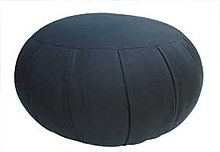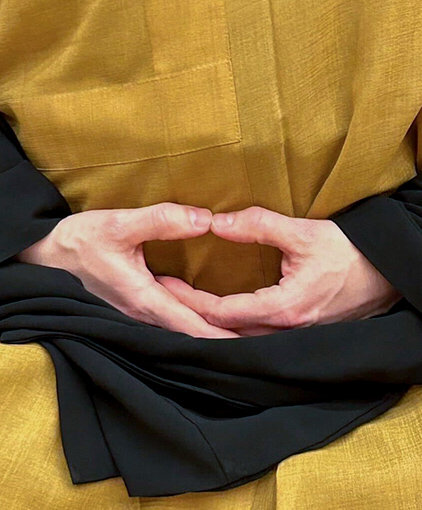What is Zazen?
Zazen
Zazen translates directly to 'seated meditation.' Unlike other forms of meditation, Zazen is considered to be the heart of Zen Buddhism, and the foundational aspect of achieving enlightenment. Zazen is the study of the self.
Instructions for Zazen Meditation:
Below is a basic step-by-step instruction on sitting zazen. Most zazen sessions in monasteries begin at thirty minutes. For beginners, your meditation periods can range from 5 minutes to 30 minutes. If you'd like to expand your Zen practice, stay consistent and practice zazen daily. Each box below provides a further in-depth description of each step.
- Find your posture. Sit in a comfortable meditation position, straighten your back, keep your eyes lowered, and place your hands in the comic mudra position.
- Practice the breath. Count each inhalation and exhalation beginning with one and ending at 10.
- Once you hit 10, restart the count back at one with the next exhale.
- "When your mind begins to wander—a thought arises and you lose your awareness in it—then clearly see or notice the thought, and then let it go and begin the count again at one" ("Zazen Instructions," 2023).
- Remain patient and steady.
-
What is Zazen? (from Encyclopædia Britannica Online)Overview of Zazen meditation provided by Britannica Online.
-
Zazen Instructions: How To Meditate (from Zen Mountain Monastery)Zazen instructions provided by Zen Mountain Monastery from Mt. Tremper, NY.
-
How to do Zazen (from Soto Zen Organization)Provided by Sojiji Head Monastery and Eiheiji Head Monastery
-
The Practice of Zazen [Pamplet]
 Shumucho's (2014) description and step-by-step instruction on sitting Zazen in a formal Zendo setting.
Shumucho's (2014) description and step-by-step instruction on sitting Zazen in a formal Zendo setting.
What You Need for Zazen
Essential Needs:
A Zafu, or a Cushion
This is where you will sit during your zazen period. While the following image is a zafu, a pillow suffices for beginners. While sitting on a cushion on the floor is the traditional position, many people also use a chair or seiza bench.

Figure 1. A Traditional Zafu (Source: Wikipedia, 2006).

Figure 2. A Seiza Bench (Source: The Monastery Store, n.d.).
A Quiet Location
Ideally, your zazen session will take place in a quiet, isolated location with minimal distractions. This is to reduce external interruptions and promote a quiet headspace to keep your focus.
Loose, Comfortable Clothing
Throughout your zazen period, you will be essentially completely still. Whether you sit in meditation for 5 minutes or 60 minutes, you want to be comfortable. You will be sitting in a posture (see the next box) that can sometimes be uncomfortable in tight or restrictive clothing. As a result, you want to wear something that will allow you to be comfortable while sitting for extended periods of time.
Optional:
An Altar
In traditional Buddhist monasteries and temples, you will likely encounter a Buddhist altar. These are not required for zazen but maybe something you may want to slowly build as your practice progresses. Altars typically consist of an image or statue of the Buddha, incense, flowers, a candle, and other honorific objects. For more information on building an altar, see Liturgy.
-
Home Altars (from the Brooklyn Zen Center)A collection of various Zen Buddhist practitioners and their home altars.
Posture & Body Placement
Seated Positions:
Burmese Position

This position (Fig. 3) is the simplest position for beginners. The knees should rest on the floor, and your butt should be placed on the front third of the zafu. Your spine should be straight, and your muscles should be relaxed. In this position, it should be relatively easy to maintain an upright body position (Zen Mountain Monastery, 2023).
Figure 3. Burmese Position. (Source: Zen Mountain Monastery, 2023).
Half Lotus Position

This position (Fig. 4) is a little more advanced. The left foot is placed on top of the right thigh (or vice versa), and the right leg is tucked under the left thigh.
Figure 4. Half Lotus Position. (Source: Zen Mountain Monastery, 2023).
Full Lotus Position

The Full Lotus position (Fig. 5) is the next step after the Half Lotus position, where each foot is placed on the opposite thigh. This position is recommended for those who are flexible in their hips. Through stretching and increasing flexibility, sitting in full lotus position can be achieved (Zen Mountain Monastery, 2023).
Figure 5. Full Lotus Position. (Source: Zen Mountain Monastery, 2023).
Additional Seated Positions (Using a Seiza or Chair):
Seiza Position

The Seiza Position (Fig. 6) is traditionally done by using the seiza bench. You can sit seiza without a bench or pillow by kneeling with the buttocks on upturned feet, as opposed to a bench or cushion (Zen Mountain Monastery, 2023).
Figure 6. Seiza Position. (Source: Zen Mountain Monastery, 2023).
Chair Position

The Chair position (Fig. 7) is done by sitting in a chair. There is no 'incorrect' or 'wrong' way to meditate; the most important part of zazen is to maintain a strong, steady, yet relaxed posture.
Figure 7. Chair Position. (Source: Zen Mountain Monastery, 2023).
All information and images can be found through Zen Mountain Monastery's Zazen Instructions: How to Meditate
The Cosmic Mudra
Hand Positioning
Traditionally, Zen Buddhists place their hands in the cosmic mudra (Fig. 8) position for the entirety of the meditation session.

According to Sotoshu Shumucho (2014), the proper way to hold your hand in the cosmic mudra is done by placing your right hand, palm up, on your left foot. Then, you place your left hand, palm up, on top of the right palm. From here, the tips of your thumbs should be touching each other.
Figure 8. Cosmic Mudra. (Source: Shumucho, 2014).